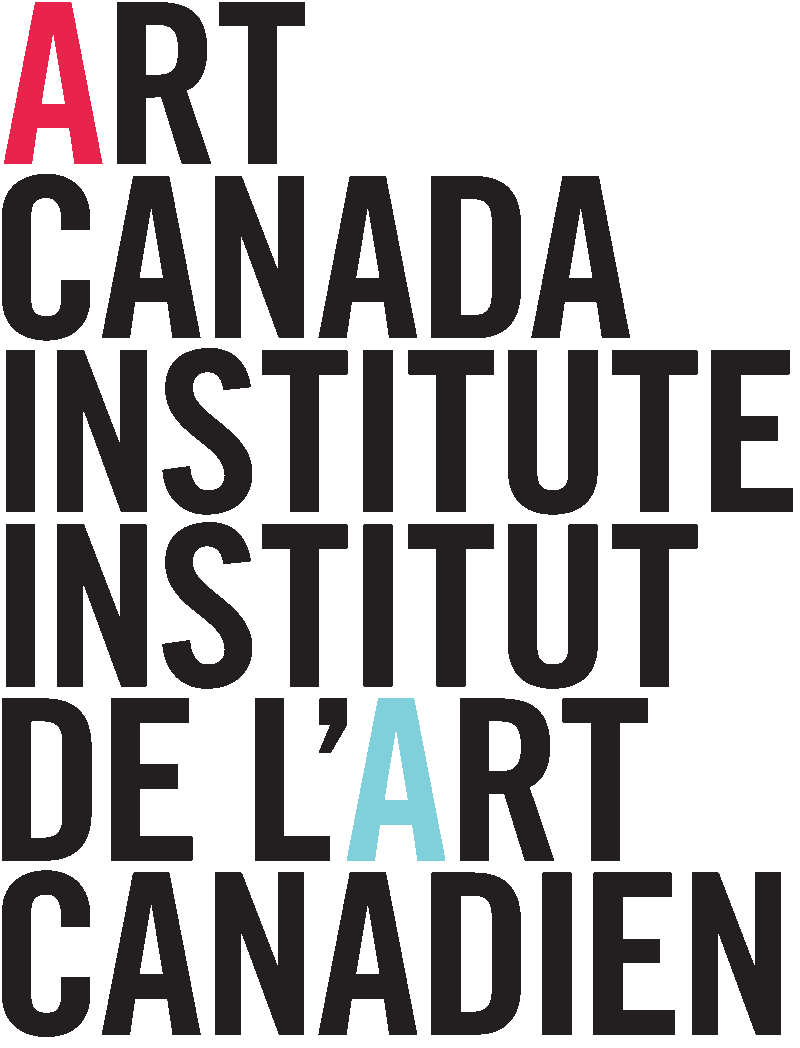F.6 Community-based Art in Research and Pedagogy
Sat Oct 21 / 10:15 – 11:45 / KC 208
chair /
- Jennifer Eiserman, University of Calgary
Within Bishop’s understanding of art’s potential to be a “de-alientating endeavour” bringing participants into relationship with each other (2006, 2012, 2013), art museums become participatory sites for social engagement, creating dialogue within the communities they serve. According to Simon (2010, 2016) they become a “platform” connecting different users as “content creators, distributors, consumers, critics, and collaborators” (p.173). Silverman (2010) elaborates on this, characterizing museums as institutions engaged in “social work,” describing the ongoing impetus of museums to address social problems, social conditions and pursue social change. Black (2021) foresees that a “participative” identity catalyzes museums to proactively partner with local communities. This roundtable invites participants exploring contemporary art museums’ roles in community engagement and social change to share their practices with the goal of forming a research network to pursue common goals. Work of the resulting network will be shared with UAAC in 2024.
keywords: museums, community-based art, community-based art education, community-based research
session type: roundtable
Jennifer Eiserman: I have been engaged in community-based art and collaborative practice for twenty-three years. The importance of making, learning, and understanding together are the driving force of my research and teaching practices. As a result, my teaching practice engages students in collaborative, community-based inquiries through practical experiences in settings as diverse as working with the homeless families of Inn from The Cold to, most recently, seniors in Calgary’s Downtown West. I am actively engaged in community-based arts groups in Calgary, including co-curator of the TBT Gallery committed to promoting Jewish Calgary artist. The community basis of this work has led me to inquire into issues involving ethnicity and identity in art/art education, including research into the nature of the contribution of Canadian artists of Chinese descent on Canadian art and currently, the role of community art in community development through involvement in the Future of Stephen Avenue project, City of Calgary.
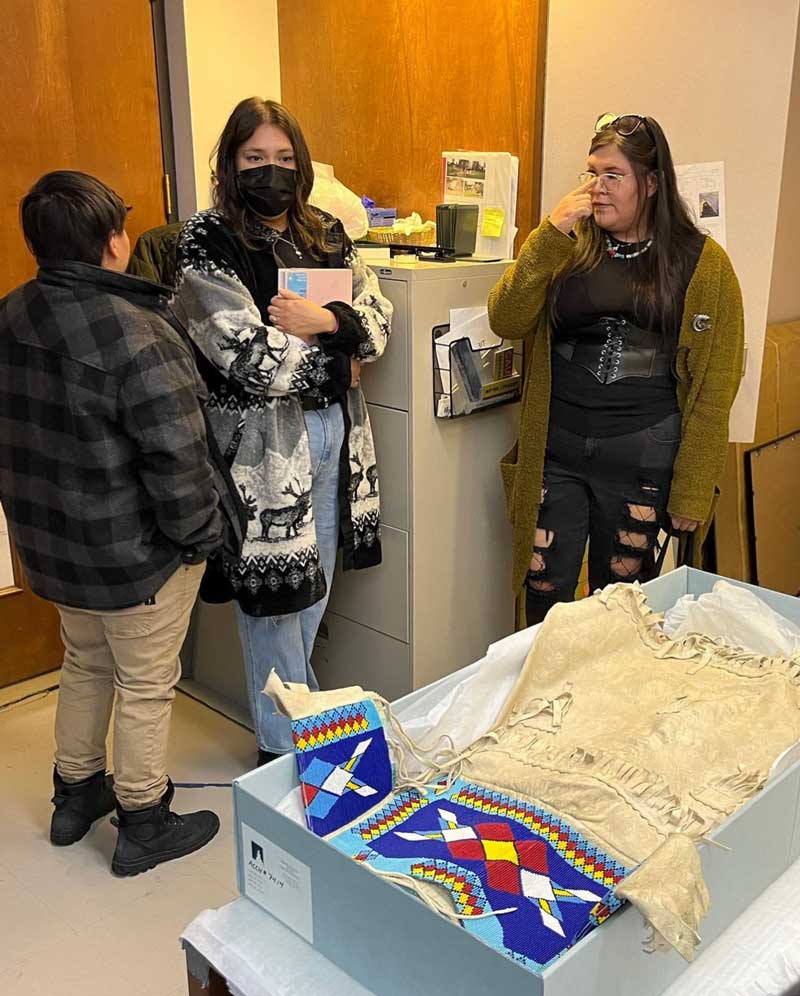
Exploring Whyte Collection, Whyte Museum, Banff, Canada, 2022
Dagugun Woakide Akide Hnebigan Echin Bathtabi (Studying Museums in a Good Way)
- Amanda Foote & Nakoda Storytellers Group: Chey Suwâtâgâ Mû, Amber Twoyoungmen, Aiden Powderface, & A.J. Baptiste, University of Calgary
This research project grew out of conversations between a museum professional and members of the Îethka (Stoney Nakoda) community at Mînîthnî (Morley Alberta). It asks, what obligations do museums have to Indigenous (and other source) communities, and what supports might museums need to meet these obligations? We are undertaking this research by visiting institutions (including museums, archives, galleries, and heritage sites) together, as well as conducting a survey and interviews.
As part of a preliminary phase of this work, in fall 2022 our group had an opportunity to explore the archives at the Whyte Museum of the Canadian Rockies through the Lillian Agnes Jones Fellowship provided by the museum. This opportunity allowed us to test methods for the overall study and yielded some interesting results.
We will present a brief overview of the process of developing the research project, and share findings from the sessions at the Whyte. Chiefly, we will highlight the need for museums to engage in compensation for work that community members take up with their collections and institutions, especially when this work does not explicitly serve the needs of the museum.
keywords: museums, Indigenous, community research, collaborative research, art
Amanda Foote is a white settler museum professional and student collaborating with a group of Îethka (Stoney Nakoda) storytellers artists exploring museums and their responsibilities. Chey, Amber, Aiden, and A.J. each have arts practices that engage in storytelling in various forms. Chey is a mural artist and traditional tattoo practitioner. Amber is a fiber artist and beader, as well as a film director. Aiden is an animator and film creator in various forms. A.J. is a writer of plays, music, and film scripts, as well as an actor performer. The group has been developing working relationships together for several years. They all live in the Bow Valley corridor.

Zine workshop (Contemporary Calgary with YYC/LRT), learning a phototransfer process together, 2023.
Fostering Skill Development and Community through Art
- Gail Hinchliffe, University of Calgary
In winter, 2023 Contemporary Calgary offered a program for seniors at the Unison at Kerby Centre. The initiative was part of the University’s YYC/LRT Community Based Art as Community Engagement research project (Jennifer Eiserman, PI). Conceived by MFA (Visual Art) student Gail Hinchliffe, the initial program outline called for participants over 55 years to share their family stories through Zines that incorporate collage, photography and drawing. The Contemporary Calgary exhibitions Human Capital (originating with the Mackenzie Art Gallery and reimagined collaboratively with Contemporary Calgary) and Astral Dance were resources to support generating ideas and approaches to using materials. Within six weekly, two hour, sessions held at Contemporary Calgary, program participants were provided with an opportunity to increase their understanding of contemporary art and connect meaningful with themselves, their art, and those around them. This presentation will explore the ways that peer learning, intergenerational engagement, and learner centred, responsive curriculum provided an opportunity for participants to extend their artmaking capacities, gain a familiarity with contemporary art, and develop friendships. This exploratory project demonstrates the potential of art as a vehicle to promote skill development and foster an opportunity for community building with an older population.
keywords: university-museum partnerships, community-based research, community-based pedagogies
Gail Hinchliffe: Founding partner, former shareholder and Director of United Active Living Inc, a company specializing in the development and operation of independent, assisted living and memory care housing and programs for older adults in Alberta. In the role of President and Chief Operating Officer, directly responsible for real estate development, operations, and meeting financial objectives. Founding operation achievements were the establishment of an inclusive model where residents with dementia are not segregated, creation of a multi-discipline operating team, and a social model with emphasis on promoting health, community, and creative expression for all residents and their families. Transition from the corporate field to an arts student commenced with the completion of a BFA from the Alberta University of the Arts in 2022 and acceptance as a MFA candidate at the University of Calgary in the same year. Continued interest in actualizing the power of art to foster well-being for older adults, including myself.
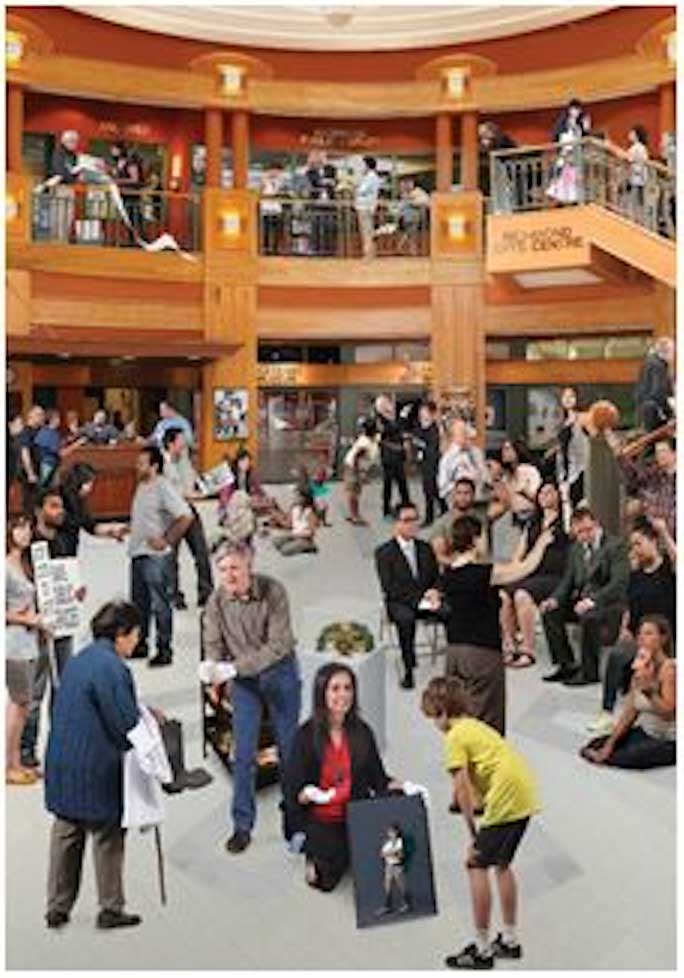
Public Matters, Richmond Art Gallery, Carole Condé and Kari Beverage, 2012
Are museums at a crossroads in our post pandemic world?
- Scott Marsden, Independent Curator
In 2022, the International Council of Museums (ICOM) approved a new definition for museums which states in part, “They operate and communicate ethically, professionally and with the participation of communities, offering varied experiences for reflection, and knowledge sharing.”
It is within this cultural context that museums need to reconsider their roles and work towards becoming more accountable and accessible to all communities. This has led to questions regarding the precarious nature of contemporary museums.
This paper considers narrative-based art practices as an alternative model in helping to re-defining community collaboration and initiate a new process of engagement with museums. Narrative-based art practices are based on the creative use of dialogue, participatory and collaborative methodologies that explore new ways of knowing and alternative practices in re-defining broad forms of community engagement in museums.
These practices explore collaboration in co-creating programming with communities in the development of a new engagement with museums. This creative process incorporates a participatory process that gives voice to those who are marginalised, disfranchised, and suppressed by dominant cultural narratives found within many museums.
These practices suggest that creative forms of dialogue can initiate new ways of engaging with museums. It is within these practices that the act of conversation becomes a critical part of the meaning making process with the aim of developing new engagement initiatives with museums, and communities. Narrative-based art practices disrupt institutionally drive programming and explore alternative ways of seeing that can transform museums into community places for dialogue.
Narrative-based art practices allows for community participants to lead in the co-creation of artistic projects. This paper asserts that narrative-based art practices offer new opportunities and possibilities in creating new engagement with museums that reflects the diversity of knowledge, histories, and stories of everyone in our communities. I will present three examples of narrative-based art practices.
keywords: dialogue, narrative, collaboration, participation, community
Scott Marsden holds a Ph.D. in Art Education from the University of Victoria, has a Master of Fine Art degree from York University and is an Associate of the OCAD University.
Mr. Marsden has 20+ years in research, developing and presenting collaborative exhibitions and public programming explores narrative-based art practices and how art galleries and museums can become public spaces for critical dialogue, informal learning, and multiple ways of knowing.
Mr. Marsden has developed a critical framework that utilizes a socially engaged curatorial practice and establishes a dialogical and collaborative approach in working with art galleries and museums.
Mr. Marsden has led community-based initiatives in museums and art galleries in presenting the rich and diverse stories of communities in Western and Northern Canada that reflect the diversity of knowledge, histories, and heritage of various communities.

Out of Place, a socially engaged installation at Esplanade Gallery, Medicine Hat, 2019.
Immigration and Re-imagining Inclusion: Art and Community
- Nurgül Balaç Rodriguez, Werklund School of Education, University of Calgary
Art, community, and immigration programs encourage participation in the life of a cultural and support local people in the development of interconnectedness. Community art and immigrant art projects have been used to bring together artists, students, local ethnic communities (groups and minorities), and to generate new procedures at the provincial and federal levels for developing community-based identity for newcomers, immigrants, and refugees in Canada (Butterwick, 2020; Clover, 2012). Communication and dialogue can play a central role in contemporary art and theory. Kester (2015) uses the concept of ‘dialogical art’ to describe practices whereby artists invite groups of people to meet to discuss topical issues and problems. Therefore, community-based art research embodies participatory and collaborative projects embracing education and public art.
For this session, I will discuss two art projects that involved learning and sharing knowledge in a gallery space. Participants included artists, audience, and staff of the art organizations. The aim of my art practice is to create space for gathering and for building new communities through engagement with various media. Out of Place, was an expansive installation, comprised of 1,095 porcelain cups. The number of cups represents the minimum number of days an individual is required to be physically present in Canada within a five-year period to be eligible to apply for citizenship, which I secured in 2018.
Re-imagining Integration engaged racialized immigrant women artists. At an institutional level, many immigrants’ foreign qualifications and professional experience are devalued (Guo & Anderson, 2006, Guo, 2013). The aim of the program was to initiate the process of developing an authentic voice for the participating artists. The project has implications for the evolution of contemporary art galleries into democratic spaces for exchanging knowledge (Brookfield, 2005, 2009; Freire, 1998; hooks, 1994).
keywords: community-based art, social change, immigration, adult education, racial habitus
Nurgül Balaç Rodriguez is an artist with an interdisciplinary practice, and is a second year PhD student at Werklund School of Education, University of Calgary. She has an active individual practice including porcelain, installation, handmade paper, printmaking, three-dimensional pieces, and more recently socially engaged and collaborative projects. Her work is social, political, and personal with a focus on issues of immigration, diasporas, borders, and cultures. She explores the phenomenon of becoming a diasporic individual during process of identity formation within a new culture. Nurgül settled in Calgary in 2009 after many nomadic years of living in Turkey, the United States and Spain with her family. She continues to live in Calgary making, writing, teaching, collaborating and always learning.
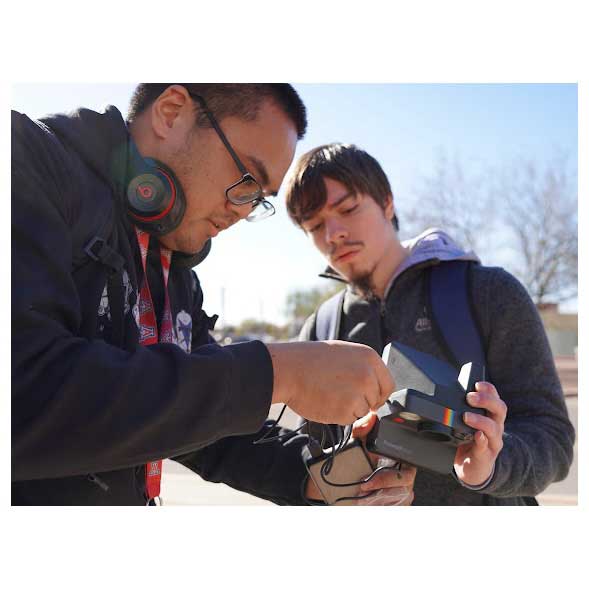
Netza Aguirre, "UArizona students and faculty, CCP curators, and community storytellers gather at El Pueblo Neighborhood Center for conversation facilitated by the Sunnyside Foundation and the Office of Congressman Raúl Grijalva," 2023
On Co-Creating Community-Based Projects with Tucson’s Southside
- Meg Jackson Fox, Center for Creative Photography, at the University of Arizona
In the last year, curators from the Center for Creative Photography (CCP) partnered with University of Arizona faculty and students and with community leaders to co-create arts engagements at El Pueblo Neighborhood Center in Tucson, Arizona’s Southside. These collaborative efforts ranged from experimental pedagogies connecting university classrooms, photography exhibitions, and community-driven re-investment work, to community arts and culture celebrations. A newly awarded grant will expand this work to include modeling a visual “living archive” that narrates El Pueblo’s rich past even as it proposes collective visioning for its future.
Founded in 1975 as the Chicano Movement flourished across the United States West, the El Pueblo Neighborhood Center is a community and cultural complex, a site to local public services (a public library and park, senior living center, health care providers); community gatherings (baby showers, Quinceañeras, weddings, retirements); cultural landmarks (historic murals and sculptures, family-owned restaurants); and now the headquarters of U.S. Congressman Raúl Grijalva. Located in some of the areas of Tucson hardest hit by uneven economic and social investment, the COVID 19-pandemic, and climate change, El Pueblo is now the focus of efforts by multiple stakeholders in the city and private sector for revitalization and reinvestment.
This ongoing collaboration investigates arts organizations’ participation in the sociocultural fabric of a city, and maximizes resources available to a cultural heritage institution like CCP and an institution of higher education like UArizona to drive impact investing into local capacity building, narrative advocacy, and community goals.
keywords: co-creation, arts engagement, community reinvestment, living visual archive, impact investing
Meg Jackson Fox is an educator, curator, and writer based in the Sonoran Desert. She currently serves as Curator of Interdisciplinary and Community Practices at the Center for Creative Photography at the University of Arizona. Prior to that, Jackson Fox was Assistant Professor of Global Contemporary Art at the University of Denver. Her professional life has brought her to work in a variety of cultural scenes, including Berlin, Washington D.C., London, Memphis, Sarajevo, Mexico City, Phoenix and Tucson. Jackson Fox’s interests lie in contemporary visual culture, experimental storytelling, and community collaborations, and she has contributed to publications, exhibitions, lectures and symposia nationally and internationally. Jackson Fox holds a PhD in Contemporary Art and Critical Theory from the University of Arizona; an MA in Art and Museum Studies from Georgetown University, jointly convened with Sotheby's Institute-London; and an MA in Modern European History from the University of Tennessee.
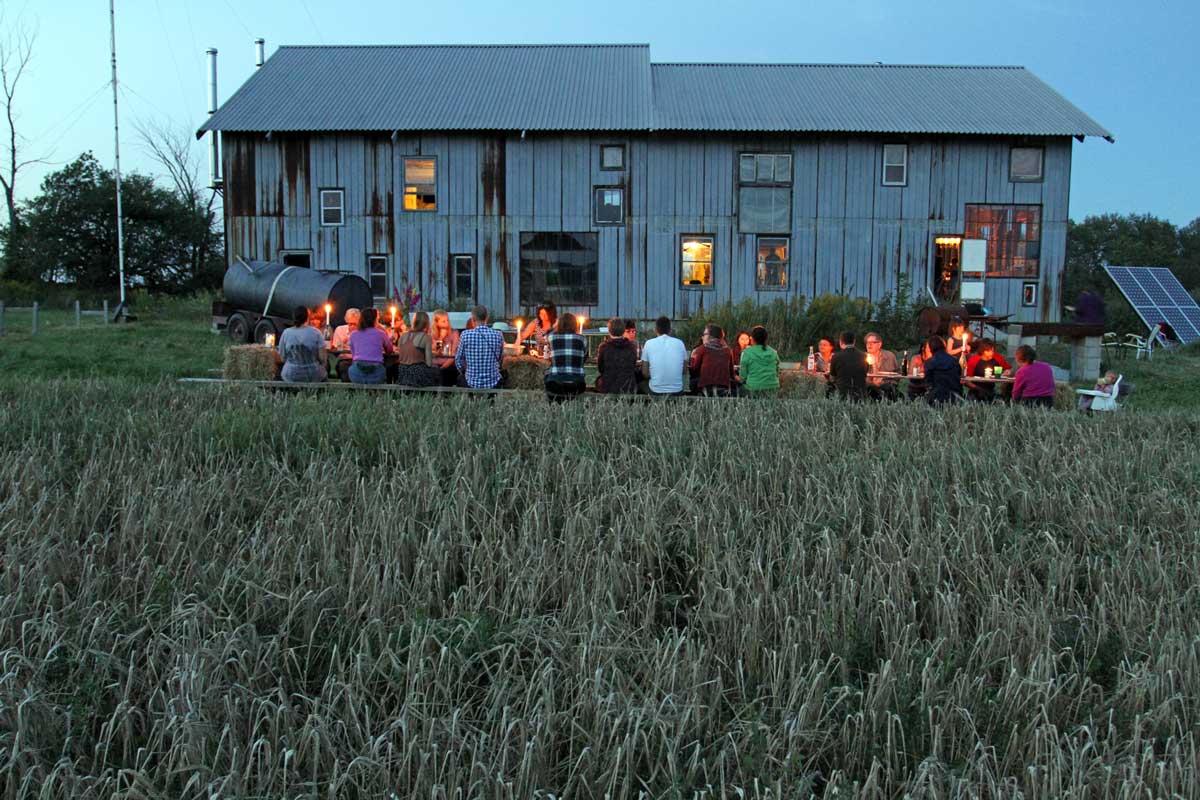
Don Blanche Fieldside Dinner, 2011
Goals vs Gifts: Community Engagement Tactics Roundup
- SWINTAK, McMaster University
After the last few years of social isolation and online living/working, in-person community engagement appears to have a more vital role than ever for the reawakening of our museums and institutions. The upsurge of things like Airbnb experiences and community workshops demonstrate an increased demand for novel forms of localized activities that bring people together.
But what are the tactics at play? How can an institution simultaneously serve their own megalithic mandates as well as that of an independent community? How do you measure success; what are the metrics of social impact? How can social projects better integrate with the network of communities to provide sustained and meaningful engagement?
The key tenets of community engagement generally include collaboration, knowledge sharing, co-creation and in general, an attempt towards social impact. Yet institutions too often approach social projects using one-off value-extraction based modes of thinking that feel geared towards grant reports more than providing participants with authorship over the space and activities.
My proposal is to contribute a map of community engagement tactics and how different organizations and groups employ them. I’d like to draw from and share my own failures and successes with social practice projects over the last decade working with groups such as Don Blanche, Critical Disability Working Group, ACT aging + communication + technologies lab, Digital Economies Lab and McGill University Health Centre Research Institute’s Brain Repair and Integrative Neuroscience Program (BRaIN), as well as my Social Practice and Community Engaged Projects class at McMaster University.
keywords: community, experimental, pedagogical, participatory, social
SWINTAK is an interdisciplinary artist, educator and context-maker who serves as Assistant Professor at the School of the Arts, McMaster University. She has led a wide range of community-based pedagogical projects both within and outside of institutional frameworks. In 2009, she co-founded Don Blanche, an experimental off-grid collective-living artist residency situated on a sprawling 60-acre property powered by solar and wind energy. In 2018, she co-created 4TH SPACE, a 3,000 square foot street-level interfaculty research presentation venue that aimed to connect the public with researchers’ work across Concordia University. As a curriculum developer she has led a range of activity-driven workshops, think tanks, University seminars and programs, collaborating with a range of organizations, artist-run centres and community groups. Her research has been supported by Social Science and Humanities Research Council of Canada, Hexagram, Canada Council for the Arts, Ontario Arts Council, European Cultural Congress and Mondriaan Fund.
